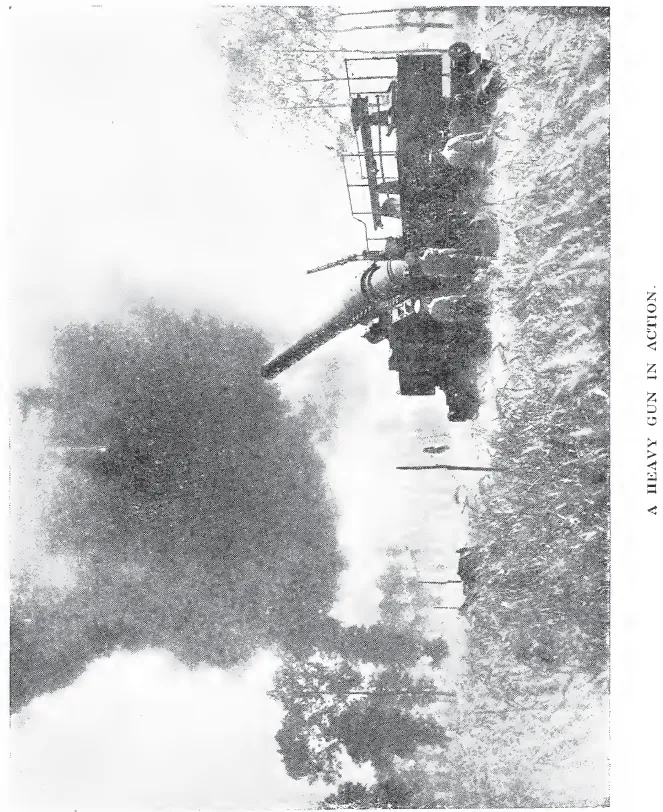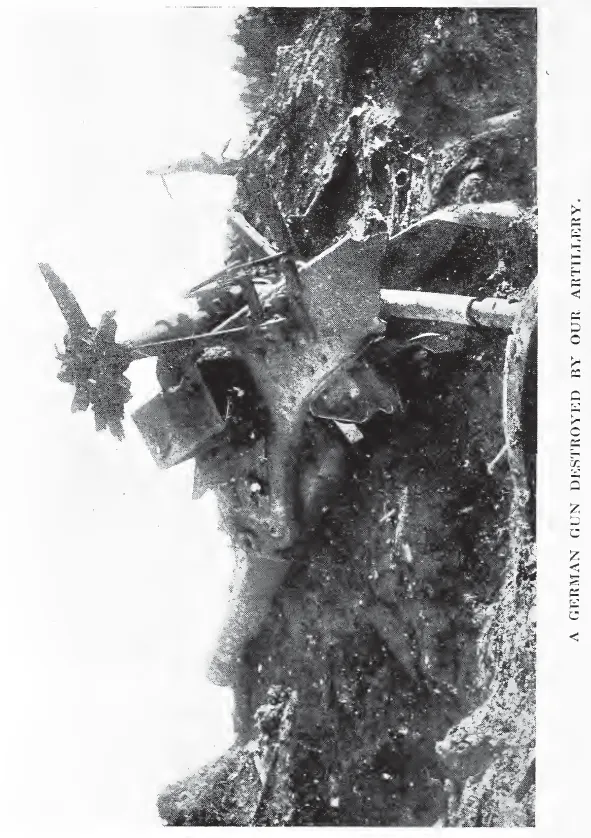![]()
CHAPTER I—THE SEPTEMBER CAMPAIGN.
THE capture of Guillemont on September 3rd meant the end of the German second position on the whole front between Thiepval and Estrèes. The Allies were faced with a new problem, to understand which it is necessary to consider the nature of the defences still before them and the peculiar configuration of the country.
The advance of July 1st had carried the first enemy lines on a broad front, but the failure of the attack between Gommecourt and Thiepval had made the breach eight miles less than the original plan. The advance of July 14th gave us the second line on a still narrower front—from Bazentin le Petit to Longueval. The danger now was that the Allied thrust, if continued, might show a rapidly narrowing wedge which would result in the formation of a sharp and precarious salient.
Accordingly Sir Douglas Haig broadened the breach by striking out to left and right, capturing first Pozières and the high ground at Mouquet Farm, and then—on his other flank—Guillemont and Ginchy. These successes made the gap in the second position some seven miles wide, and brought the British front in most places to the highest ground, from which direct observation was obtainable over the lower slopes and valley pockets to the east. We did not yet hold the complete crown of the ridge, though at Mouquet Farm and at High Wood we had positions which no superior height commanded.
The German third position had at the beginning of the battle been only in embryo. Before the attack of July 14th it had been more or less completed, and by the beginning of September it had been greatly elaborated and a fourth position prepared behind it. It was based on a string of fortified villages which lie on the reverse slopes of the main ridge Courcelette, Martinpuich, Flers, Lesbœufs, and Morval. Behind it was an intermediate line, with Le Sars, Eaucourt l’Abbaye, and Gueudecourt as strong positions in it; and further back a fourth position, which lay just west of the Bapaume-Peronne road, covering the villages of Sailly-Saillisel and Le Transloy. This was the line protecting Bapaume; the next position at this moment only roughly sketched out, lay well to the east of that town.
Since the battle began the Germans had, up to the second week in September, brought 61 Divisions into action in the Somme area; 7 had been refitted and sent in again; on September 14th they were holding the line with 15 Divisions—which gives us 53 as the number which had been used up. The German losses throughout had been high. The French casualties had been singularly light—for they had fought economically under close cover of their guns, and had had, on the whole, the easier tactical problem to face. The British losses had been, beyond doubt, lower than those of the enemy, and our most conspicuous successes, such as the advance of July 1st south of Thiepval and the action of July 14th, had been achieved at a comparatively small cost. Our main casualties arose from the failure north of Thiepval on the first day, and the taking of desperately defended and almost impregnable positions like Delville Wood and Guillemont. In the ten weeks’ battle the enemy had shown many ups and downs of strength. At one moment his whole front would appear to be crumbling; at another the arrival of fresh batteries from Verdun and new troops would solidify his line. The effort had strained his capacity to its full. He had revived the old First Army—which had been in abeyance since the preceding spring—and given it to von Below north of the Somme, while the Second Army, now under von Gallwitz, held the front south of the river. He had placed the Crown Prince of Bavaria, commanding the Sixth Army, in charge of the sector comprising his own and the First and Second Armies. He had followed the British plan of departing from the old Corps system and creating groups —through which a large number of Divisions, drawn from many Corps, were successively passed. He had used in his defence the best fighting material he possessed. During those ten weeks almost all the most famous German units had appeared on the Somme—the cream of the Bavarian troops, the Fifth Brandenburgers, and every single Division of the Guard and Guard Reserve Corps.
![]()
In the early days of September there was evidence that the enemy was in no very happy condition. The loss of Ginchy and Guillemont had enabled the British to come into line with the left wing of Fayolle’s great advance, while the fall of certain vital positions on the Thiepval Ridge gave us observation over a great space of country and threatened Thiepval—which was the pivot of all the German defence in the northern section of the battle-ground. The Allied front north of the Somme had the `river as a defensive flank on its right, and might presently have the Ancre to fill the same part on its left. Hence the situation was ripe for a further thrust which, if successful, might give our advance a new orientation. If the German third line could be carried it might be possible to strike out on the flanks, repeating on a far greater scale the practice already followed. Bapaume itself was not the objective, but a thrust north-eastward across the upper Ancre, which might get behind the great slab of unbroken enemy positions from Thiepval northwards. That would be the ultimate reward of a complete success; in the meantime our task was to break through the enemy’s third line and test his powers of resistance.
It seemed a propitious moment for a concerted blow. The situation on the whole front was good. Fayolle’s left wing had won conspicuous successes and had their spirits high, while Micheler was moving his pincers towards Chaulnes and playing havoc with the main German lateral communications. Elsewhere in Europe things went well for the Allies. On August 28th Rumania had entered the war and her troops were pouring into Transylvania. As it happened, it was a premature and fruitless movement, but it compelled Germany to take instant steps to meet the menace. There had been important changes in the German Higher commands, and it might reasonably be assumed that von Hindenburg and von Ludendorff were not yet quite at ease in the saddle. Brussilov was still pinning down the Austro-German forces on the Russian front and Sarrail had just begun his serious offensive in the Balkans. In the event of a real débâcle in the West the enemy might be hard pressed to find the men to fill the breach.
Every action, it should be remembered, is a packet of surprises. There is an immediate local objective, but on success any one of twenty consequences may follow. The wise commander cannot count on any of these consequences, but he must not neglect them in his calculations. If the gods send him good fortune he must be ready to take it, and he naturally chooses a season when the gods seem propitious.
On Tuesday, September 12th, a comprehensive bombardment began all along the British front from Thiepval to Ginchy. The whole of Sir Henry Rawlinson’s Fourth Army was destined for the attack, as well as the right Corps—the First Canadian—of the Fifth Army, while on the left of the battle to another Division was allotted a preliminary attack, which was partly in the nature of a feint and partly a necessary preparatory step. The immediate objective of the different units must be clearly noted. On the left of the main front one Canadian Division was directed against Courcelette. On their right a Division of the New Army—that Scottish Division which had won high honour at Loos—had for its task to clear the remains of the old Switch Line and encircle Martinpuich, but not—on the first day at any rate—to attempt the capture of what was believed to be a most formidable stronghold. Going south, two Territorial Divisions—Northumbrian and London—had to clear High Wood. On their right the New Zealanders had Flers as their objective, while two Divisions of the New Army had to make good the ground east and north of Delville Wood. Next to them the Guards and a Division of the old Regulars were to move north-east from Ginchy against Lesbœufs and Morval, while on the extreme right of the British front another Division of London Territorials were to carry Bouleaux Wood and form a defensive flank.
The forces to be used in the new advance were for the most part fresh. The Guards had not been in action since Loos the previous September, the Canadians were new to the Somme area, while it was the first experience of the New Zealanders on the Western Front. Two of the Divisions had been some considerable time already in the front trenches, but the others had been brought up for the purpose only a few days before. All the troops were of the best quality, and had a proud record behind them. More perhaps than any other part of the battle this was an action of the British corps d’élite.
In this stage, too, a new weapon was to be used. The “tanks,” officially known as “Machine Gun Corps, Heavy Section,” had come out from home some time before and had been parked in secluded spots at the back of the front. The world is now familiar with descriptions and pictures of those strange machines, which, shaped like monstrous toads, crawled imperturbably over wire and parapets, butted down houses, shouldered trees aside, and humped themselves over the stoutest walls. They were an experiment which could only be proved in practice, and the design in using them at this stage was principally to find out their weak points, so as to perfect their mechanism for the future. Their main tactical purpose was to clear out redoubts and nests of machine-guns which, as...
![The Battle Of The Somme –The Second Phase. [Illustrated Edition]](https://img.perlego.com/books/RM_Books/inde_pub_group_sqonxaw/9781782890683_300_450.webp)

